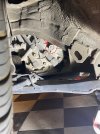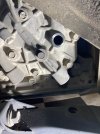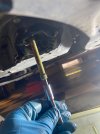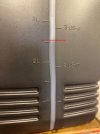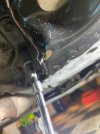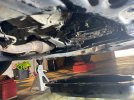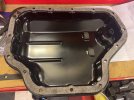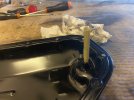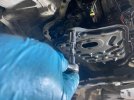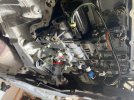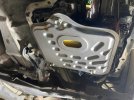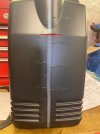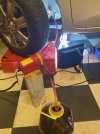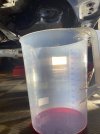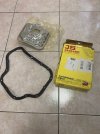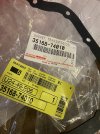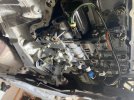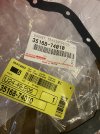Registered
July 18, 2023
Messages
10
Località
Applicable tutorial for the entire series of AISIN CVT transmissions K41A - K41B - K410 - K411 installed by Toyota. The IQ 1.0 is equipped with the K41A, while the IQ 1.3 has the K41B. It is preferable to park the car in the garage the night before, to start the work with a cold engine (and transmission) (i.e., at room temperature). To replace the CVT oil, the car must be lifted and on a level surface to avoid affecting the oil level reading. The filling cap is located behind the left front wheel (driver's side), some prefer to remove the wheel, I chose to leave it in place, by turning the wheels to the right, you can still access the 24mm bolt (marked TC) for filling new oil. It is advisable before unscrewing the drain bolt to ensure that the filling bolt has been unscrewed (or at least loosened).
After unscrewing the drain plug with a 6mm Allen key, insert the same key into the drain hole, where there will be a plastic tube to unscrew (do not force it too much), unscrew it...more oil will come out. This tube serves the function of 'correct oil level' (therefore very important) instead of the usual dipstick for checking the oil level.
At this point, if the replacement is only aimed at changing the oil (without opening the cap), once the oil has finished dripping, you can screw the tube back in (up to the stop) and then proceed with filling the cap with new oil through the loading/filling hole. The oil drained from my car (covered 109 thousand km... never replaced I believe) came out quite dark, practically black. It was maintenance that had become urgent in order not to compromise the functionality of the CVT which, in case of problems, could represent about half the value of the car on its own. Quantity of oil drained, about 2.5 liters.
Drain the oil cup, then proceed to unscrew the cup itself to clean and replace the CVT oil filter. There are 15 bolts of 10mm.
And finally, the cup has been disassembled (if the cup does not come off after removing all the bolts, gently pry it off with a large slotted screwdriver)
Disassembled the cup, check the amount of iron filings present...and of course, clean everything, that is, the inside of the cup and the 2 magnets. Don't forget to remove the old gasket from the cup to be replaced by the new one.
Detail of the plastic tube, its function is to measure the 'correct amount of oil' in the CVT, when filling the CVT with new oil.
After removing the cup, move on to the oil filter, there are 3 other 14mm bolts.
Attention to the old filter's o-ring, it must be removed and replaced with the new o-ring mounted directly on the new filter
As for the amount of oil, considering the oil previously drained from the drain plug cup (+ tube), then the oil that came out when removing the cup, and finally, the oil that came out when removing the oil filter, in total, it is about 4.2 liters of oil. Knowing how much oil has been drained in total can be useful to have a comparison term (more or less) regarding the amount of oil needed for refilling.
After reassembling the filter, fitting a new cup gasket, reassemble the cup (using the usual 15 10mm bolts). Tighten the bolts slowly, gently tightening them by continuously going around all the bolts (in short... the gasket should not be crushed only on one side, but there should be a uniform and gradual compression around the entire perimeter of the cup). Make sure the plastic tube (only the tube, not the cap) is screwed into the cup's drain hole (we need it for the first level). After all this... proceed to the filling/transfusion phase with new, original Toyota oil, bright red in color. To load the oil, I used a 12V pump bought at LIDL some time ago.
Fill with new oil until it comes out of the cup (overflow of the plastic tube). Wait for the oil to drip from the cup, then screw on the cup cap.
Screw in the drain plug (6mm hex key), without tightening too much. Add another 400ml of oil through the filling hole and screw in the filling bolt (do not tighten too much... it's temporary). Start the engine and, while pressing the brake pedal, move the gear lever 2/3 times from P to B (and vice versa), leaving the lever in each position for about 3 seconds. This maneuver is used to circulate all the oil (both new and old oil remaining inside) and meanwhile heat up the oil itself. Check the oil level when the oil is in the range between 35 and 45 degrees Celsius (due to oil expansion caused by temperature and the level of the plastic tube). Note that with an external temperature of about 27 degrees, the oil took about 6-7 minutes to reach 38-40 degrees Celsius. To detect the oil temperature, I used the MINI VCI J2534 Diagnostic Cable with Techstream software (available for 35-40 euros on Ebay) connected to the car's OBD port. It's the same diagnostic tool used by Toyota in the workshop (used for many things, diagnostics, clearing DTC errors, customizing car options, etc.).
When the oil is within the temperature range specified by Toyota (35-45 °C), with the car running, loosen the drain plug of the pan...if oil comes out, wait for it to drip and then tighten the drain plug (this time you can tighten it well). If no oil comes out, while keeping the car running, proceed to fill with more new oil through the fill hole until it comes out of the pan...wait for it to drip and tighten everything (drain plug and fill plug). Done. Test the car to verify correct operation of the transmission and/or any oil leaks/seepage. Materials used: - Toyota TC GWS 3320 CVT Oil (5 liters) (98 euros) - Oil pan gasket p.n. 35168-74010 (20 euros)
- Oil filter p.n. JT605K purchased in Singapore ( https://www.fitinpart.sg/index.php?route=product/product&product_id=828895 ) (50 euro)
- OBD Diagnostic Cable MINI VCI J2534 + Teachstream software (40 euros) Time taken: about 3.5 hours calmly and without haste.
For ordinary maintenance (this has been extraordinary), I intend to proceed with the mere replacement of the oil that drains from the sump (+ tubing), every 3 years or 40,000 kilometers (whichever comes first). In this way, by replacing just under half of the gearbox oil every 3 years, the CVT always runs with (more or less) fresh oil.
Guido for years American cars with automatic transmission and by frequenting Yankee forums where the automatic transmission has always been used, I understood that the replacement of oil (and filter) is essential to avoid very expensive troubles (which in Italy often, they don't even know how to fix, beyond the costs). Byeee
Ciaoooo
Last update: July 30, 2023
Reactions: Il Cecca, Macco26 and giana3
Registered
July 18, 2023
Messages
10
Località
After about 20 days, I update the post... The car had been recently purchased used, the transmission was working fine (otherwise I wouldn't have bought it), etc. The person who sold it to me told me that the transmission oil, despite having had numerous services at the dealership, had never been replaced because 'these are Toyota transmissions, they are sealed, the oil is for Life.' Well... I just made sure the transmission was still working fine and one of the first maintenance tasks I did was to replace the CVT oil. Now, 15 days after replacing the CVT oil, I can notice the difference... it shifts much smoother, quieter, and it seems like now I can actually feel the gear changes... something that didn't happen before.
So....if you haven't done it yet....do it. Highly recommended.
Reactions: Il Cecca e Alligusta

